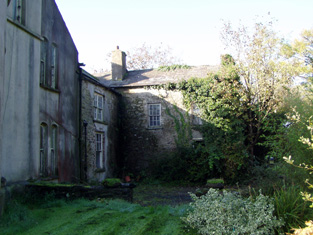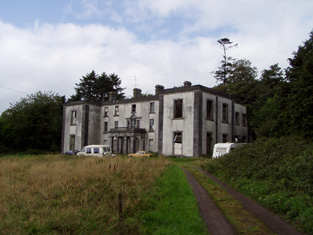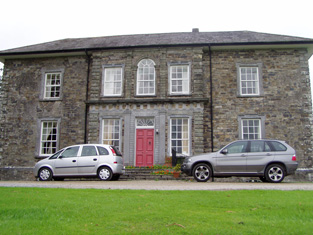Ballyglass/Ballyclough House
Houses within 5km of this house
Displaying 15 houses.
Houses within 5km of Ballyglass/Ballyclough House
Displaying 15 houses.
| House name | Description | |
|---|---|---|
| Aghern/Ahern House | Brabazon Esq was resident in the 1770s and 1780s. The home of Spotswood Bowles in the first half of the 19th century. The buildings were valued at £47+ in the early 1850s and held from the representatives of William Beamish. Spotswood died in 1864 and was succeeded by his son George who was in turn succeeded by his nephew Spotswood in 1886. Relatives of the Bowles owned this property until the 1970s. In 1942 the Irish Tourist Association Survey mentions the ruins of Aghern Castle in the grounds of Mrs. Spotswood Bowles property. Aghern was uninhabited for a time but has recently been restored. |

|
| Kilbarry (Castlelyons) | Hajba writes that a new house was built here in 1842 by the Wigmores. Robert Wigmore was resident in 1814, E[dward] Wigmore in 1837 and Henry Wigmore in the early 1850s when the buildings were valued at £23 and held in fee. In 1786, Wilson states that it was the residence of Hon. Mr. Moore. Later the home of the Kent and Waters families. Still extant and occupied. |

|
| Careysville | Careysville Castle, originally known as Ballymacpatrick Castle, was the seat of the Carey family from the late 17th century. In 1750 Careysville was occupied by John Carey and Peter Carey was resident in 1814. In 1837 Lewis refers to “the handsome modern mansion built on the site of Careysville castle” by E.K. Carey. Valued at £50 in the mid 19th century the Careys held this property in fee. Inherited by the Montgomerys of Killee and sold by them to the Duke of Devonshire in the mid 20th century. In 1942 the Irish Tourist Association Survey noted that the house was then unoccupied as Captain Montgomery had moved into a modern bungalow nearby. Careysville is now in use as a fishing lodge offering luxury accommodation. |

|
| Glandulane House | Robert Briscoe had a house and flour mill in the townland of Clondulane North in the mid 19th century, which he held from the Earl of Mountcashel. The house was valued at £25.10 shillings and a flour mill at £96. Later the home of the Hallinans and the O'Donnells. A house is still extant at the site but the mill buildings are now ruinous. |

|
| Moydilliga/Modeligo | In the mid 19th century this house was the home of Henry Braddell. It was valued at £16 and held by him in perpetuity. Wilson, writing in 1786, refers to it as the seat of Mr. Armstead. By 1906 the mansion house at Moydilliga was valued at £42 and occupied by Henry Braddell. In the early 20th century the property passed to the Haskins-Braddells. Sold by them in 1950, this house is still a family home. |

|
| Kilmurry | The house was built in the early 18th century and remained in the hands of the Grant family until sold to the Rosminian Order in the 1930s. In the 1940s the Irish Tourist Association surveyor was given to understand that the Grants still retained title to the property and were residing in South Africa. In the mid 19th century it was valued at £37 and held by Thomas St John Grant in fee. At the beginning of the 21st century this house was in a dilapidated state. |

|
| Leitrim | Home of the Campion family for two centuries, sold by them in the 1870s to Major Victor Reeves of the Castle Kevin family. In 1943 the Irish Tourist Association Survey referred to it as the residence of David Nunan, formerly owned by the Campions, "in their day the house was thatched and much smaller". This 17th century house is still a residence. |

|
| Ballyrobert | Hajba writes that Michael Mackay built a house beside the ruined castle of Ballyrobert in the 1820s and he is recorded as resident there by Lewis in 1837. In the early 1850s the house was valued at £23, occupied by Michael Mackay and held from John Peard. Michael J. Mackey occupied the house in 1906. This house no longer exists. | |
| Coole Abbey | This house was the home of a branch of the Peard family until the early 20th century and is still inhabited. It was occupied by Richard Peard in 1814 and by Henry Hawk Peard in 1837. He was still resident in the early 1850s and held the house valued at £36 from James H. Smith Barry. By the end of the 19th century Orr McCausland was the owner of Coole Abbey. |

|
| Waterpark | Originally a Pyne residence which later passed through marriage to the Cavendishes. In 1786 Wlson refers to "the ruins of Water Park, the seat of the late Lord Chief Justice Pine". Hajba writes that other occupants were the Watkins and Drew families. There was no house of more than £2.10 shillings valuation in this townland, held by George Walker, at the time of Griffith's Valuation. | |
| Rathbarry Cottage | Rathbarry Cottage was occupied by Major William Love Peard at the time of Griffith's Valuation. The property was held from the Reverend R. Gumbleton and the buildings were valued at £11. Some ruined walls remain at the site. | |
| Towermore | The home of Mrs Maria Oliver in 1837 but leased to Frederick C. Hayes in the early 1850s. The house was valued at £45. Maria was the widow of Charles S. Oliver of Inchera and a daughter of A. Morris of Dunkettle. A. Morris Oliver is recorded as a subscriber to Lewis ''Topographical Dictionary'' published in 1837 but is not mentioned in Burkes. Earlier, in 1786, Wilson refers to Tormore as the seat of Mr. Connor. This house was not occupied at the end of the 20th century although still extant. | |
| High Park | Occupied by the Reverend J. W. Edgar in 1837 and by Bridget Hogan in the mid 19th century, valued at £12+ and held from William Coppinger. This house no longer exists. | |
| Carrigmore | Richard Power was resident here in 1814 and Edward Morragh in the mid 19th century. Morragh held the property from the Duke of Devonshire and the buildings were valued at £18+. Later the home of the Cronin family. Hajba writes that this house has been unoccupied since 1990. | |
| Thornhill | A Nason home, first occupied by John William Washington Nason. His widow Mrs Barbara Nason is recorded as resident at the time of Griffith's Valuation. Valued at £18.11 shillings the house was held from the Duke of Devonshire. The Nason family continued to live here until the mid 20th century. The house is still an occupied residence. |

